
Center for Glass Research (CGR)
New York State College of Ceramics at Alfred University (lead institution)
A National Science Foundation Industry/University Cooperative Research Center since 1986
Partner Institutions:
- Alfred University
- University of Missouri-Rolla
- The Pennsylvania State University
Benefits of advanced glass research extend from improved processing techniques and materials for glassmaking, to scientific knowledge of glass surfaces and interfaces, to stronger and more versatile glasses.
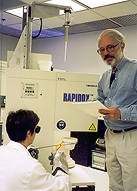
|
Center Mission and Rationale
In 1985, a core group of glass industry representatives, realizing the need for a cooperative research center for glass science and engineering, formed the Center for Glass Excellence. Alfred University was selected to lead the research, following a national competition among 11 universities. In 1986, the Center qualified for designation to the National Science Foundation Industry/University Cooperative Research Centers Program. From a charter membership of 8 corporate sponsors, the consortium of the Center for Glass Research (CGR) grew to include over 30 glass manufacturers, glass processors, suppliers to the glass industry, and government agencies.
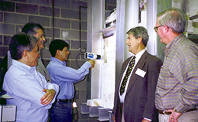
|
The research program has extended to three university sites that specialize in basic and advanced glass research (Alfred University), glass surfaces and interfaces (The Pennsylvania State University), and refractories for glassmaking (University of Missouri-Rolla). Research is also conducted at the Institute for Silicate Chemistry in Russia and at the Virginia Military Institute. The mission of the Center is to advance the field of glass science and engineering through a research, education, and technology exchange that is driven by the cooperative efforts of academe, industry, and government. To achieve this mission, the CGR conducts basic and preproprietary research directed toward glass and glass melts, materials for glassmaking, and improved understanding of glass surfaces and interfaces and their role in the formation of products.
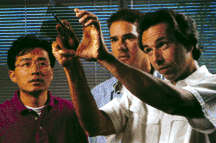
|
Research Program
The CGR research program covers nearly every aspect of glass science and engineering and reflects the interests of Center members, with emphasis on fundamentals of glassmaking. Specific areas include the following:
- Industrial glass melting and processing
- Properties of glass-forming melts
- Advanced glass research
- Glass surfaces and interfaces
- Modeling and predictions
- Materials for glassmaking with special interest in refractories.
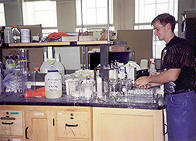
|
The research projects are selected and evaluated by the corporate sponsors at semiannual meetings, after extensive interaction with faculty research scientists on a one-to-one basis, and through the research subcommittee system. CGR research is conducted by science and engineering faculty and graduate assistants at participating universities and at affiliate organizations in Europe, Asia, and the United States. A full complement of equipment and analytical facilities is available at the research sites and includes specialized glass melting and processing facilities; measurement equipment for the properties of glasses and their melts; electron and optical microscopes; Mossbauer, Raman, UV, visible, and IR spectrometers; x-ray analysis and surface analysis equipment; fiber drawing equipment; and pilot glass-melting facilities. CGR sponsors have incorporated research findings into their glassmaking processes, resulting in substantial savings and more efficient research strategies. Members have also sponsored proprietary research projects, which have included effects of oxy-fuel firing on viscosity of glass melts; ultrasonic-assisted melting and fining of glass; development of statistical property-composition models; more efficient strengthening of glass by ion-exchange (a potential major breakthrough for architectural use); and creation of a process control algorithm now widely used in industry.
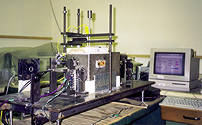
|
Special Center Activities
Over the life of the Center, faculty researchers and graduate assistants with industrial and government sponsors have solved problems in basic glass science, collaborated internationally to catalyze scientific breakthroughs, and facilitated communication among glass scientists and glass manufacturers around the world through a number of activities and accomplishments, including:
- Established the only Ph.D. in glass science in the United States and supported the largest glass science and engineering undergraduate curriculum in the United States
- Fostered a Visiting Scientist Program that has enabled scientists and engineers from sponsor companies and agencies to accelerate their own research at an academic site
- Published a technical review periodical, The Glass Researcher: Bulletin of Glass Science and Engineering, which is distributed to over 8,000 readers in the United States and over 30 other countries, compliments of CGR members
- Established international scientific collaborations with a German counterpart, Huettentechnische Vereinigung der Deutschen Glasindustrie (HVG), with the Glass Processing Forum of Japan through international meetings (1995, 1998), and at the Russian Institute of Silicate Chemistry through sponsored research on glass properties
- Initiated a series of international glass conferences, "Advances in the Fusion and Processing of Glass"
- Conducted the "Modeling for the Glass Industry Workshop" in collaboration with the U.S. Dept. of Energy/Office of Industrial Technologies (DOE/OIT) (1996)
- Sponsored extensive studies in molecular dynamics (MD) modeling (Dr. Alastair Cormack), acclaimed to be in the "forefront of the field"
- Received a three-year, $1.2 million grant from the DOE/OIT to develop a glass melt properties database to serve the modeling needs of the glass industry
- Created a device to imitate frictional contacts encountered in the glass manufacturing process and during the lifetime of a glass article (Dr. Jacqueline C. Rolf and Dr. W. C. LaCourse).
Center Headquarters
Center for Glass Research
Alfred University
New York State College of Ceramics
Alfred, NY 14802
Tel (607) 871-2432 &183; Fax (607) 871-2383
Homepage: http://cgr.alfred.edu
Center Director: Dr. Thomas P. Seward III
seward@alfred.edu
Site Director: Dr. Robert E. Moore
(573) 341-6326 &183; rmoore@umr.edu
Site Director: Dr. Carlo G. Pantano
(814) 863-2071 &183; pantano@ems.psu.edu
Center Evaluator: Carla C. Johnson
(607) 871-2945 &183; ccjohnson@alfred.edu
NSF 01-168j